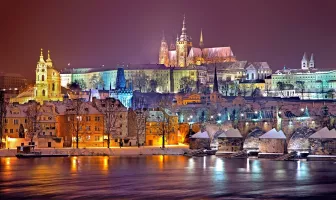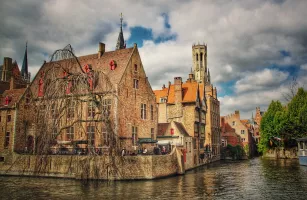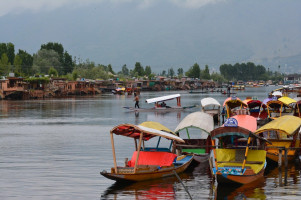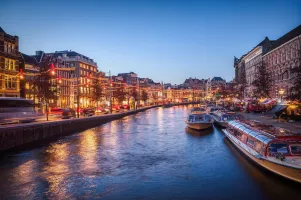Church of Our Lady Victorious and The Infant Jesus of Prague
Duration
1 to 1 Days
1 to 1 Days
Best time to visit
Theme
Religious, Heritage
Religious, Heritage
Church of Our Lady Victorious and The Infant Jesus of Prague Travel Guide
Church of Our Lady Victorious and The Infant Jesus of Prague is a famous religious site located in Prague, Czech Republic. The church is renowned for its historical significance, stunning architecture, and the revered statue of the Infant Jesus of Prague. Visitors come from all over the world to see this miraculous statue and to experience the spiritual atmosphere of the church.Top Attractions in Church of Our Lady Victorious and The Infant Jesus of Prague
- The Infant Jesus of Prague Statue
- The Baroque Architecture of the Church
- The Miraculous Stories Associated with the Statue
- The Peaceful Courtyard Gardens
Church of Our Lady Victorious and The Infant Jesus of Prague is Famous for
Its revered statue of the Infant Jesus of Prague, known for granting miracles and answering prayers.Top Attractions in Church of Our Lady Victorious and The Infant Jesus of Prague
- Experiencing the Spiritual Aura of the Church
- Attending Mass and Praying before the Statue
- Exploring the History of the Church through Guided Tours
- Relaxing in the Tranquil Courtyards
What's Great about Travelling to Church of Our Lady Victorious and The Infant Jesus of Prague?
- Perfect for spiritual seekers and religious pilgrims
- Rich historical and cultural experience
- The opportunity to witness a revered religious icon
What's Not So Great about Travelling to Church of Our Lady Victorious and The Infant Jesus of Prague?
- May not appeal to travelers seeking non-religious attractions
- Can be crowded during peak tourist seasons
- Limited dining and shopping options in the vicinity
Travel Tips for Church of Our Lady Victorious and The Infant Jesus of Prague
- Respect the religious significance of the site
- Check the opening hours before visiting
- Dress modestly when entering the church
- Photography may be restricted in certain areas
Important Church of Our Lady Victorious and The Infant Jesus of Prague trip information
- Ideal Duration: A few hours to half a day
- Best Time to Visit: Early morning or late afternoon to avoid crowds
- Nearby Airports and Railway Stations: Prague Vaclav Havel Airport and Prague Main Railway Station
Total
5,32,000
*EXCLUDING APPLICABLE TAXES 5.0 Ratings
( 20 Reviews )
( 20 Reviews )
Total
4,63,000
*EXCLUDING APPLICABLE TAXES 5.0 Ratings
( 20 Reviews )
( 20 Reviews )
Per Person
2,88,500
*EXCLUDING APPLICABLE TAXES 5.0 Ratings
( 20 Reviews )
( 20 Reviews )
Per Person
23,600
*EXCLUDING APPLICABLE TAXES 3.7 Ratings
( 5 Reviews )
( 5 Reviews )
Per Person
3,92,000
*EXCLUDING APPLICABLE TAXES 5.0 Ratings
( 20 Reviews )
( 20 Reviews )
14N/15D Netherlands, France, Switzerland & Italy Tour Package with flights from Hyderabad - 2 Adults
Amsterdam, Luzern, Paris, Rome, Venice, Zurich
14 Nights / 15 Days
Per Person
2,79,500
*EXCLUDING APPLICABLE TAXES 5.0 Ratings
( 20 Reviews )
( 20 Reviews )
FAQ's on Church of Our Lady Victorious and The Infant Jesus of Prague
Q1: What is the best time to visit The Czech Republic?
The best time to visit The Czech Republic is during the spring (April to June) and fall (September to October) when the weather is mild, and the crowds are smaller. Summer (July and August) is also popular but can be crowded with tourists. Winter (December to February) is ideal for those interested in winter sports and Christmas markets. Consider visiting during the shoulder seasons for a balance of good weather and fewer tourists.
Q2: Do I need a visa to travel to The Czech Republic?
Most visitors from the EU, the US, Canada, Australia, and New Zealand do not need a visa for stays up to 90 days. However, it's essential to check the specific visa requirements based on your nationality before traveling. Make sure your passport is valid for at least six months beyond your intended stay.
Q3: What are the must-visit attractions in The Czech Republic?
The must-visit attractions in The Czech Republic include Prague Castle, Charles Bridge, Old Town Square, Cesky Krumlov, Kutna Hora Bone Church, and the beautiful Bohemian and Moravian countryside. Don't miss exploring the charming towns like Karlovy Vary and Olomouc, and tasting the famous Czech beer in local pubs.
Q4: Is The Czech Republic a safe place to travel?
The Czech Republic is considered a safe destination for travelers. However, like any other city, be cautious of pickpocketing in crowded areas, especially in tourist hotspots like Prague. It is advisable to stay alert and take general safety precautions, such as keeping valuables secure and being aware of your surroundings.
Q5: What is the local currency in The Czech Republic and can I use credit cards?
The local currency in The Czech Republic is the Czech Crown (CZK). While credit cards are widely accepted in hotels, restaurants, and larger stores, it's advisable to carry some cash for smaller establishments and local markets. ATMs are readily available in cities and towns for easy currency exchange.
Q6: What is the local cuisine like in The Czech Republic?
The Czech cuisine is hearty and flavorful, with dishes like goulash, roast pork with dumplings, and svickova (marinated beef with cream sauce). Don't miss trying traditional snacks like trdelnik (chimney cake) and svarak (mulled wine). Vegetarians can enjoy options like fried cheese and potato dishes. Czech beer is famous worldwide, so beer enthusiasts should indulge in local brews.
Q7: What transportation options are available in The Czech Republic?
The Czech Republic has an efficient transportation system, including buses, trams, and metro in major cities like Prague. Intercity trains are convenient for traveling between cities, and renting a car is a great option for exploring the countryside. Taxis are available but can be expensive, so it's recommended to use reputable services or transportation apps.
Q8: Are there any cultural norms or etiquette I should be aware of when visiting The Czech Republic?
When visiting The Czech Republic, it's important to greet people with a handshake, maintain eye contact during conversations, and address others using formal titles unless invited to use first names. Tipping is customary in restaurants (usually 10%), and it's polite to wait for the host to say "dobrou chut" (enjoy your meal) before eating. Respect local customs, such as removing shoes when entering homes or certain establishments.
Q9: I am a travel agent. How can I buy travel leads of Church of Our Lady Victorious and The Infant Jesus of Prague?
Register yourself as a travel agent at agents.tripclap.com and then you can buy travel leads to Church of Our Lady Victorious and The Infant Jesus of Prague once your account is approved. For more details contact our support team at +91-8069186564 or support@tripclap.com





